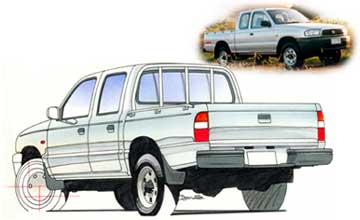BY STEVEN BUTCHER | 8th Jan 2002

Combine this with the excellent build quality maintained by Mazda and the differences between light commercial vehicles begins to become apparent.
The B-Series range incorporates the above mentioned 2.5-litre turbo-diesel engine delivering 86kW and 280Nm of torque (as tested), plus a 2.6-litre petrol engine with 92kW and 206Nm in Single Cab Utility, Single Cab/Chassis, Cab Plus Utility, Cab Plus Chassis and Dual Cab Utility formats, mounted on a full-length, overlapped box section chassis in two and four-wheel drive configuration. (Single Cab Utility is available in 4x2 petrol only, while Cab Plus Cab/Chassis is available in 4x4 only).
The B-Series range is simple yet totals 15 vehicles in all. There is a base model DX with five-speed manual transmission (or optional four-speed auto for 4x2 Single Cab/Chassis and 4x2 Dual Cab Utility Petrol models only), and an SDX model available in 4x4 dual cab only.
The SDX comes with added creature comforts such as velour cloth seats/door trim and electric mirrors and windows. Colours are also basic and include Cool White, Passion Rose, Highlight Silver and Dusk Green.
Those opting for the base model DX won't be disappointed, as short of the window winder it is hard to spot the difference. The interior is basically two shades of grey for everything except the instrument panel, gear knobs and steering wheel, which are black.
The colours are serviceable and the coverings are tough and easy to clean but the dark grey dash and black steering wheel get extremely hot in the sun and radiate a lot of heat in the cab. The model tested had Mazda's integrated CFC-free air-conditioning fitted as an optional extra and this worked extremely well for both demisting and cooling, with only minimal drag on the engine.
The payload space and carrying capacity of the Mazda B-Series are similar to its rivals. The same is true of the body options, four-wheel drive running gear, transmission choices and suspension.
Most light commercial utility vehicles are built to a standard set of requirements - overall size, carrying capacity, seating, engine power and economy, price and lifetime service costs. In this type of vehicle you won't find highly innovative features and technology but you will find hardwearing, practical features plus the knowledge of long component life and a generally long vehicle life.
Having said that, Mazda has paid attention to the new B-Series and designed a 13 per cent stronger passenger cage and fitted it with side impact bars, a collapsible steering column and increased the leg and headroom significantly to make it a more comfortable and safe vehicle to drive.
The use of galvanised or organic resin-coated steel throughout the body and the application of paint by cathode electro-coating and sealant to all joined surfaces should ensure the vehicle is protected from corrosion.
The Bravo rides best in the Dual Cab 4x4 format, as the driving position is more open and the added weight of the larger cab across the mid point of the vehicle reduces the seesaw effect of the high load rear springs.
Engine-speed sensitive power steering is standard and is nicely weighted to match the vehicles size and length, (5135mm overall). Bridgestone Dueler HT 205R16 C-8 (16-inch) tyres on styled steel rims absorb most road lumps and bumps, and the Bravo's torsion bar front suspension reacts slowly and predictably to large potholes, staying firm as you enter corners or brake heavily even with a load on.
Traction on all surfaces is good, mainly due to the fitting of a limited slip differential out back - which is standard on 4x4 but not available on 4x2. The rear suspension is a basic rigid axle with under-slung leaf springs and double acting shock absorbers.
The rear springs on the first release of vehicles were a little soft according to Mazda, which is good for handling when the vehicle is unloaded but does mean they can lose their set quicker. Stiffer springs are now fitted to all B-Series vehicles.
Naturally, if you plan to carry a load much of the time the Single Cab models will provide a comfortable ride as well but don't expect too much - this is still a light commercial despite the car-like interior.
Out on the highway the turbo-diesel Bravo will happily drop into fifth gear at around 80km/h and stay there for the day, up hills or casually overtaking, returning excellent economy as it turns over at 2750rpm at just on 100km/h quietly! Just remember to allow a bit of room between you and the car in front, though, as the drum brakes on the rear need more than a few rotations to slow you down.
As an off-roader, you should expect never to be embarrassed by the Bravo, as in the right hands it is a very competent four-wheel drive, despite its less than sophisticated suspension.
Traction, torque and ground clearance are the three things most needed on steep, rough tracks, and this B-Series has all that - though without the limited slip diff it might be a different story.
The new-look Bravo is a safe bet to return value for money and in the long-term good resale potential if well maintained. The B-Series Mazda is not the top seller in its market segment but it comes close if you add sales of the Ford Courier, which is a re-badge of the Mazda Bravo.